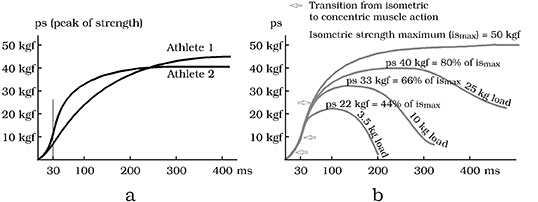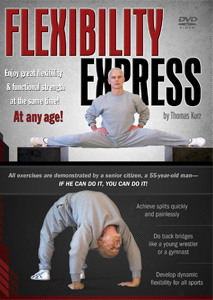by Thomas Kurz
In Part II you will learn more about sport-specificity of strength training. (Click here to read Part I of “Sports Skills and Strength Training.”)
In 1968, Soviet scientist U. I. Ivanov published the results of an experiment showing that different kinds of strength exercises develop distinctly different kinds of strength. He had three similar groups do strength training twice a week for three months. The first group did typical (concentric) dynamic weight exercises, the second group did static strength exercises (isometric) with maximal tensions, and the third did yielding (eccentric) exercises with weights exceeding by 10-40% what they could lift in a normal (concentric) way.
After three months, compared to their own previous performance, the first group on the average could lift 8.5 kg more in a squat, 5.5 kg more in a clean to chest, jump 3.7 cm higher, and pull with 14.6 kg more force in a back strength test. The second group on the average could lift 9.2 kg more in a squat, 12.7 kg more in a clean to chest, jump 5.4 cm lower than before training, and pull with 30.0 kg more force in a back strength test. The third group on the average could lift 15.0 kg more in a squat, 9.7 kg more in a clean to chest, jump 1.6 cm lower than before training, and pull with 19.1 kg more force in a back strength test.
As you can see, athletes tested strongest in the tasks that were most similar to the exercises they did. Those that performed dynamic exercises (group one) were best at jumping. Those that did static exercises (group two) were best at the static pull in back strength test and the clean to chest–a rather slow lift—and worst at jumping. Finally, those who did eccentric exercises (group three) improved best in the squat, done as a slow movement in this test.
There are more kinds of strength than just the two most basic kinds—dynamic and static—a division based on the relationship between the muscle’s length and tension during efforts.
Static or isometric strength is used when the tension of a muscle increases while its length remains constant. Example: holding a weight. Strength is gained in the muscle within 40° (plus or minus 20°) of the angle held during isometric exercise. At 90°, for example, there’ll be a gain within 70° to 110° (Baechle 1994). Increasing static strength does not always cause an increase of dynamic strength (Wazny 1992).
Dynamic strength is used when the length of a muscle changes while the muscle tenses. Dynamic strength is divided into slow strength, speed strength, amortizing strength, reactive strength, explosive strength, and starting strength.
Amortizing or yielding strength is used in fast eccentric actions such as landings.
Reactive strength is used for fast switching from eccentric to concentric action such as landing and immediately jumping up. It is used in track and field jumps and in all jumps other than those done from standing still. In martial arts, it is used when launching a flying kick.
Slow strength is used when near maximal mass is given minimal acceleration. For example, when a heavy barbell is lifted slowly.
Speed strength denotes the result of dividing one’s maximal strength value in a given movement by the time it takes to reach that value (Tidow 1990), or in simplified terms, the ability to exert maximal force during high-speed movement (Baechle 1994).
Explosive strength is the ability to rapidly increase force (Tidow 1990). The steeper the increase of strength in time the greater the explosive strength (see Fig. 1). It can be also defined as the ability to apply as much force as possible in the shortest time and is useful in all situations where a considerable mass has to be moved quickly, for example, in sprinting starts and in grappling throws. To a large extent it determines athletes’ results in all speed-strength sports such as judo, wrestling, karate, track-and-field jumps and throws, and weightlifting.
Starting strength is the maximal amount of force one can develop at the beginning of movement (in the first 30 milliseconds after beginning the contraction).
Fig. 1: Strength curves for different athletes and for various weights (Tidow 1990)
Graph curves showing the strength increase for different amounts of resistance are identical for a given athlete (Tidow 1990). No matter how great or small is the resistance (how heavy or light is the weight), the initial part of the curves representing the gradient of strength related to time is the same. What differs depending on the amount of resistance is the time it takes the athlete to generate enough strength to overcome the resistance and move (for example, move the weight). In other words, that difference relates to the time it takes to make a transition from isometric muscle action to concentric muscle action, as you see on the Fig. 1. Athletes with high starting strength can move a light object sooner than those with lower starting strength. Boxing punches, fencing touches, or badminton strokes are actions in which high starting strength is an advantage (Platonov 1997).
A long time ago a study was done comparing the strength of judoka and of taxi drivers. Both groups had similar maximal static strength but the judoka had much greater explosive strength. In a practical sense, this means that judoka can pull or push and throw their opponent long before people with less explosive strength could generate enough force to move their challenger.
All these kinds of strength are not closely correlated. People of similar maximal static strength can have very different speed strength, explosive strength, and reactive strength. Starting strength and explosive strength are not closely correlated either, but both can be increased independently with specific strength exercises.
A good example of the need to match your strength exercises to the task is training for increasing your jumping ability.
The height of your jump depends on the vertical velocity of your center of gravity at takeoff. The greater the force and the longer the time that force acts on your body the greater that velocity and the higher the jump. The only way to extend the time the force has for acting is to increase the distance the center of gravity travels, so there is more time for acceleration. Unfortunately, the human anatomy limits the effectiveness of this method, because lowering the center of gravity requires bending the knees, and bending them below 140 degrees reduces the efficiency of leg muscles. This leaves you with only one option—to increase your force by making your muscles stronger. But how? When the duration of takeoff is 120 milliseconds (long jump) or 240 milliseconds (high jump straddle style), then that is all the time you have for using your force. Your strength training for jumping ability has to enable you to generate as much force as possible in that short time. Slow squats with huge weights will increase your maximal strength but they will not develop explosive strength. And what good is great maximal strength if you can’t use it within the split second you have for the takeoff?
So you see that increasing maximal strength alone is not a guaranteed way to achieve a better jumping ability. You need to keep your takeoff short. This is where plyometrics can fit into your strength training regimen. In Part III of “Sports Skills and Strength Training” you will learn when and how to use plyometric exercises.
This article is based on the book Science of Sports Training: How to Plan and Control Training for Peak Performance. Get the book now and have all of the info—not just the crumbs! Order now!
References
Baechle, T. 1994. Essentials of Strength Training and Conditioning. Champaign, IL: Human Kinetics.
Ivanov, U.I. 1981. “Utilization of various kinds of muscle work in connection with rationalization of speed-strength preparation of weightlifters and throwers.” quoted by Wazny, Z. in Teoria i Metodyka Sportu, T. Ulatowski ed. Warszawa: Sport i Turystyka.
Platonov, V. N. 1997. Obshchaya teoriya podgotovki sportsmenov v olimpiyskom sportie. Kiev: Olimpiyskaya Literatura.
Tidow, G. 1990. “Aspects of strength training in athletics.” New Studies in Athletics 1.
Wazny, Z. 1992. “Sila miesniowa.” In Teoria sportu (Trening n. 1/13), ed T. Ulatowski. Warszawa: Sport i Turystyka.
If you have any questions on training you can post them at Stadion’s Sports and Martial Arts Training Discussion Forum



